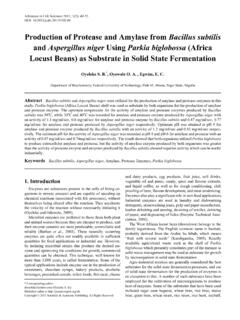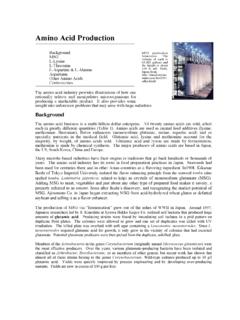Transcription of ALPHA-AMYLASE FROM BACILLUS LICHENIFORMIS …
1 Chemical and Technical Assessment 61st JECFA 1 (6) ALPHA-AMYLASE FROM BACILLUS LICHENIFORMIS CONTAINING A GENETICALLY ENGINEERED ALPHA-AMYLASE GENE FROM B. LICHENIFORMIS (THERMOSTABLE) Chemical and Technical Assessment (CTA) First draft prepared by Zofia Olempska-Beer FAO 2004 1 Summary The -amylase described in this document is a genetically engineered enzyme that is thermo-stable and active at a relatively low pH and low calcium concentration. These characteristics make the enzyme particularly suitable for use in starch hydrolysis conducted at high temperatures, for example, for starch liquefaction in the production of nutritive sweeteners from starch.
2 The genetically engineered -amylase is manufactured by pure culture fermentation of the nonpathogenic and nontoxigenic BACILLUS LICHENIFORMIS production strain. The enzyme is subsequently purified, concentrated, and formulated with appropriate substances. The formulated -amylase is referred to below as the -amylase preparation. The -amylase preparation is currently marketed under a trade name Liquozyme X. The manufacturer of these products, Novozymes A/S, submitted a dossier to JECFA containing detailed information about the -amylase and -amylase preparation (Novozymes A/S, 2002). This Chemical and Technical Assessment is based on Novozyme s dossier. The -amylase was developed from another thermo-stable -amylase (Termamyl LC) by changing four amino acids in the polypeptide chain. These modifications were accomplished by introducing appropriate mutations into the DNA sequence encoding the Termamyl LC -amylase.
3 The engineered gene, designated as the LE399 -amylase gene, was introduced into the host strain SJ5550. The host strain was developed from a parent strain DN2717, a derivative of a natural B. LICHENIFORMIS isolate. The DN2717 strain was genetically engineered to inactivate the following native genes: the apr gene encoding the Alkalase protease; the amyL gene encoding the Termamyl -amylase; the xyl gene encoding xylose isomerase; and the gnt gene encoding gluconate permease. Three copies of the LE399 -amylase gene were successively inserted in place of the inactivated amyL, xyl, and gnt genes. In a separate step, the gene encoding C-component protease was deleted. The resulting strain was designated as MOL2083 and used as a production strain. The DNA introduced into the production strain is well characterized and does not contain genes that would result in the production of toxic or undesirable substances.
4 The LE399 -amylase gene is stably integrated into the B. LICHENIFORMIS chromosome. Therefore, the probability of its transfer to other microorganisms is low. The production strain does not contain genes encoding antibiotic-inactivating proteins. Thus, neither antibiotic-inactivating proteins, nor DNA encoding such proteins would be present in the -amylase enzyme preparation. The LE399 -amylase was assessed for potential allergenicity. Its amino acid sequence was compared to the amino acid sequences of known allergens listed in publicly-available protein databases. No immunologically significant sequence homology was detected. This result suggests that the LE399 -amylase is not likely to cause allergic reactions in individuals consuming food manufactured with the use of the LE399 -amylase. In addition, the LE399 -amylase is functionally equivalent to other -amylases used in food as well as -amylases naturally present in food.
5 Alpha-amylases present in food have not been reported to cause allergy. Chemical qnd Technical Assessment ALPHA-AMYLASE from BACILLUS LICHENIFORMIS 61st JECFA 2 (2) The -amylase preparation is intended for use in starch liquefaction in the production of sweetener syrups, as well as in the production of alcoholic beverages and beer. The LE399 -amylase is not expected to be carried over to syrups. The absence of the -amylase protein in the final (purified) syrup was experimentally confirmed. The LE399 -amylase would not be carried over to alcoholic beverages because ethanol is removed from the fermentation mash by distillation.
6 In brewing beer, the LE399 -amylase is active in the mash. It would be subsequently inactivated during wort boiling and removed during beer purification. In conclusion, no residues of the LE399 -amylase are expected to be present in food processed with the use of the LE399 -amylase preparation. 2 Description The -amylase preparation is a brown liquid with a density of about g/ml. It contains active -amylase and other components that stabilize the enzyme and prevent microbial growth. 3 Manufacturing Construction of the host strain A BACILLUS LICHENIFORMIS strain SJ1707 was used to develop the host strain for the genetically engineered -amylase LE399 gene. The SJ1707 strain was developed from a parent strain DN2717 that is a sporulation-deficient derivative of a natural isolate. The DN2717 strain naturally produces a subtilisin-type protease, known as Alkalase and an -amylase, known as Termamyl.
7 The strain has been used in the production of enzymes since 1972. The strain has also been used to develop a number of amylase production strains through genetic engineering. The DN2717 strain was genetically modified to inactivate genes coding for Alkalase protease and Termamyl -amylase. The Alkalase gene (apr) was inactivated by inserting a chloramphenicol resistance gene, cat. The -amylase gene (amyL) was replaced with a fusion gene consisting of the -amylase signal peptide sequence and the Thermoanaerobacter cyclodextrin glucanotransferase (CGTase) coding sequence (cgtA). Subsequently, the chloramphenicol resistance gene, cat, was removed by replacing it with an Alkalase gene inactivated by an internal deletion. The resulting strain SJ1707 is CGTAse positive, Thermamyl -amylase negative, Alkalase protease negative, and chloramphenicol sensitive. The SJ1707 strain was subsequently modified by introduction of deletions in the xyl gene encoding xylose isomerase and the gnt gene encoding gluconate permease.
8 The inactivation of these genes resulted in the loss of the ability to utilize xylose and gluconate as carbon sources. The modified strain containing these deletions (designated as SJ5550) requires either xylose or gluconate for growth in the absence of other carbon sources. The SJ5550 was used as a host for the LE399 -amylase gene. Construction of the -amylase gene The LE399 -amylase is an enzyme with improved specificity and specific activity as well as stability at low pH and low calcium concentration at high temperatures in comparison with other -amylases. Alpha-amylases used in food processing require calcium ions for stability. In industrial applications, such as starch processing, up to 40 mg/kg calcium is added when wild-type (naturally-occurring) -amylases are used. Calcium must be subsequently removed to avoid fouling of evaporators and inactivation of glucose isomerase used in the production of fructose syrup.
9 This is done by ion exchange and results in a large volume of wastewater high in salts. The starting gene for the development of the LE399 -amylase was the modified B. LICHENIFORMIS -amylase gene used in the production of Novozyme s product Termamyl LC (Novo Nordisk, 1999). The Termamyl LC gene was constructed by combining selected DNA sequences from the BACILLUS amyloliquefaciens -amylase gene and the wild-type B. LICHENIFORMIS -amylase gene and by introducing mutations (via site directed mutagenesis) that resulted in five amino acid substitutions. The Termamyl LC gene was modified by introduction of additional mutations. The mutated gene was designated as the Chemical qnd Technical Assessment ALPHA-AMYLASE from BACILLUS LICHENIFORMIS 61st JECFA 3 (3) LE399 -amylase gene.
10 The introduced mutations resulted in substitutions at four additional amino acid positions as compared with the Termamyl LC -amylase. These changes improved performance of the LE399 enzyme and increased its stability at low pH and low calcium concentration at high temperatures. The LE399 -amylase coding sequence is associated with the amyL promoter (variant P4199) and amyL terminator both derived from the B. LICHENIFORMIS -amylase (amyL) gene. Only well-known bacterial vectors were used in the construction of the LE399 gene. The modified LE399 B. LICHENIFORMIS -amylase amino acid sequence has been compared with the amino acid sequences of other naturally occurring B. LICHENIFORMIS -amylases. The homology was found to be within the range of natural sequence variation of B. LICHENIFORMIS -amylases. Construction and characterization of the production strain To construct the -amylase production strain, three copies of the LE399 -amylase gene were successively introduced into the chromosome of the SJ5550 host strain using conjugative plasmids carrying the LE399 gene flanked by either xyl, gnt, or amyL B.















